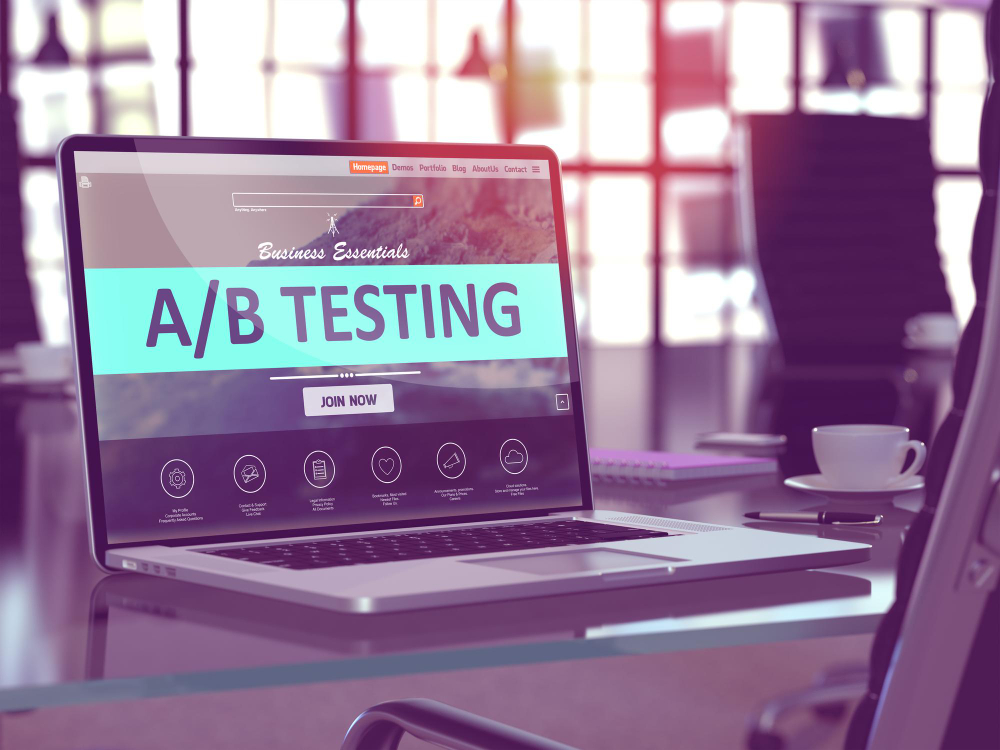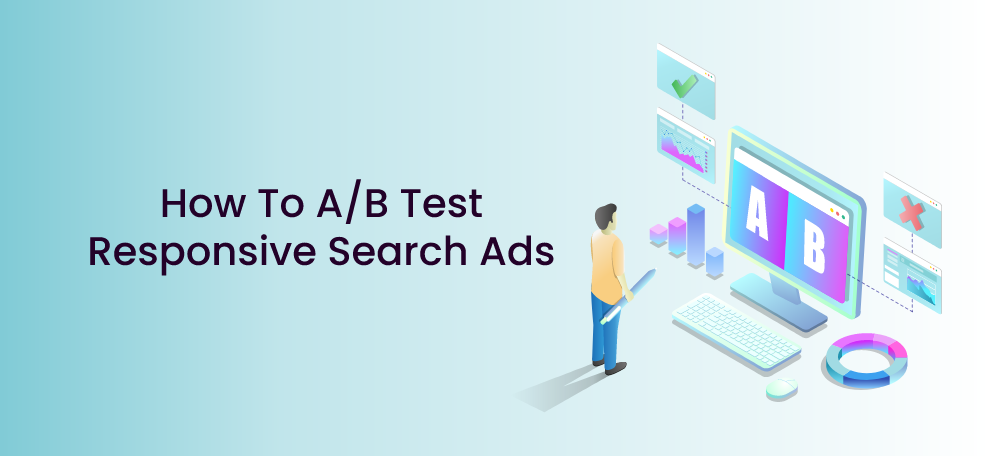Responsive search ads (RSA) are an amazing ad format, which offers extensive automation in the most relevant ad delivery. It’s really effective, and Google is highly encouraging advertisers to use it. However, when we test it with the traditional approach, it seems to look ineffective against other ad formats.
Let’s learn about the ad A/B testing and how you should A/B test your RSAs.
What is A/B Ad Testing?

In simple words, A/B ad testing is testing various ad copies and finding out the best one. Nowadays, most PPCs add multiple ads in an ad group and set the ad rotation to Optimize: Prefer best performing ads. This way, Google shows the best-performing ads by itself.
Mostly, people focus on CTR or conversion rate while testing their ad campaigns. However, higher CTR doesn’t mean conversion, and maximum conversion ads may have fewer clicks. So, it’s recommended to consider the CPI (Conversion Per Impression) to find the best ad that meets your goals efficiently.
However, when the traditional testing approach is used for RSAs against other ad formats like ETAs (Extended Test Ads), RSA’s performance looks poor. In most cases, RSAs have high CTRs, but lower conversion rates, which makes RSA look inefficient.
When more information came on this subject, it has been seen that with the traditional testing approach, the true strength of responsive search ads remains hidden.
Let’s learn about this.
Ineffectiveness of Traditional A/B Testing of RSA
RSAs are more qualified to serve in search ad auctions that ETAs were previously ineligible for due to the nature of RSA automation and larger character count. As a result, comparing RSAs to ETAs is unfair. In rare circumstances, RSAs will appear for queries that are completely unrelated to ETAs. Instead of comparing RSA performance to ETAs, start evaluating incremental lift at the ad group level to fully comprehend the RSA’s influence on performance.
How to A/B Test Your Responsive Search Ads
Here is a Case Study from Metric Theory:
They split up an ad group into two segments based on an equitable distribution of impression and click volume. Hereafter, they proceeded to run three ETAs in each ad group in our control group. After that, one RSA was added to each ad group in our test group, in addition to the three ETAs.
When comparing the RSA ad groups to the non-RSA ad groups, a definite positive trend in CTR and CVR has been recorded for the ad groups with RSA.
They found larger gains in clicks and impression volume for the ad groups with the RSAs when we looked at the period over period analysis:
The impression and click volume for the control ad groups stayed essentially stable during the period, leading to assume that the RSAs had a favorable influence on increasing overall impression and click volume for these ad groups.
It’s noticed that the RSAs outperformed the ETAs when comparing major ad copy assessment metrics in this scenario.
Anyone would have lost out on the necessary information that RSAs produced incremental increases in impressions within ad groups if they only assessed them against ETAs.
This is just one example of how to assess the effectiveness of your Responsive Search Ads.
Best Practices for Responsive Search Ads A/B Test
1. Don’t Obsess Over Ad Strength
Google delivers quick feedback in the shape of an Ad Strength indicator when you create a new RSA.
Even before your RSAs serve, Ad Strength is a best practice score that gauges the relevance, quantity, and variety of your responsive search ad content.
According to Google’s presentations, every 3% improvement in ad intensity equates to a 3% increase in clicks.
Moving from ‘poor’ to ‘average’ should result in around 3% more clicks, and going from ‘average’ to ‘excellent’ should result in another 3%.
The ad strength meter is a best-practice statistic that should only be used when starting a new RSA. However, it’s important to note that this is a ‘best practice’ score that has no bearing on real performance.
It’s conceivable to have a low-quality score keyword that generates important conversions for your account, just as it’s possible to have an ad with low ad strength that outperforms ads with higher scores.
Try to stick to Google’s standards so that you have the best chance of winning your next exam.
But don’t get too caught up in striving to achieve perfection. Your asset performance grouping labels will represent the real performance, so let’s look at those next.
2. Optimize According to Performance Labels
Asset labels provide you insight on which sections of text are doing well and which you should consider tweaking once your RSA has accumulated around 5,000 impressions at the top of the search pages over the preceding 30 days.
Google has a handy table that explains what the various performance grouping labels mean.
The most crucial thing is to replace any assets marked with the ‘Low’ label, as well as any assets that have not received any impressions after more than two weeks.
Keep in mind that the data in this assets report is based on real results. This is more relevant than the ad strength score when optimizing.
3. Test Ideas
Make many RSAs, each with a unique core message. The brand name, a distinctive value proposition, and a call to action are the core message aspects of every ad, whether RSA or ETA.
Because your brand is your brand, and most advertisers don’t have a lot of leeways to be creative with that, the value proposition and call to action are the ideal ones to play with.
The messages that performed effectively in the first trial are tested in different placements in the second experiment.
This may be accomplished by anchoring a group of assets to various places, such as a certain headline or description.
Google also allows you to pin multiple assets to a place, so if your value proposition has four assets, you can pin all four to the chosen area. When you conduct your A/B test, you can discover that pinning the value proposition to the headline 2 position works well.
However, there is something that you should consider about pinning.
Data suggests that advertisers get the highest CTR when they let the algorithms run their course without intervening. In this situation, the CPC and CPA are likewise lower.
When marketers want more control, they should provide the computer with at least two text alternatives for each pinned location.
The most significant negative impact on CTR, CPC, and CPA is pinning a single piece of text to a spot.
Multiple asset pinning appears to provide a reasonable blend of control and performance.
4. Vary Headlines
The Ad Strength indicator considers how many headline and description versions you supply. Coming up with 15 headlines may be difficult, but it’s really worth it.
It’s discovered that advertising with more headline variants resulted in more conversions per ad. So, when it comes to A/B testing RSAs, the more headlines, the better.
That’s it. Follow these in your responsive search ads A/B testing.
Tips for Creating Responsive Search Ads
1. Add required headlines
2. Avoid redundancy
3. Make sure all combinations make sense
4. Highlight key value proposition
5. Be smart with keyword insertion
6. Pin your USPs
7. Track performance
Evolving Advertising Automation
Google Ads has evolved significantly in recent years, and the company continues to introduce new features and ad formats that depend largely on machine learning and automation to optimize performance. Users must give more power in order to profit from insights and optimization capabilities, and responsive search advertisements are the newest contribution.
There will always be conventional advertisers among us who like nothing more than analyzing results and fine-tuning advertising manually. There’s no doubting the value of human touch in crafting a highly targeted commercial that resonates with certain audiences.

However, most firms today lack the time or resources to manually target and optimize their adverts at a large scale. And, as additional big data insights become accessible to aid in real-time ad targeting, it would be foolish to disregard this resource and risk falling behind the competition.
There are now a variety of bid management solutions and predictive advertising technologies available that make it simple to synthesize and automatically draw insights from consumer data in order to optimize bids and reduce ad spend waste. Advertisers who use machine intelligence and automation to outbid and outperform their competitors are already reaping the rewards.
Machine learning and automation tools in Google Ads are no exception, and they arrive at an ideal moment for most busy advertisers. Responsive search advertisements are only one illustration of where ad development, optimization, and bid targeting are headed. Advertisers that choose to accept and fully exploit new technologies will be the first to demonstrate their benefits. Automation and machine learning will be the way of the future in advertising in the long term.
Conclusion
Although A/B testing has long been a popular means of experimenting with ad variations, the arrival of responsive search advertisements necessitates a shift in A/B testing because the old method of submitting several ads to an ad group may not provide results.
Keep in mind that perceptions are influenced by factors other than keywords. And you should keep this notion in mind when A/B testing RSA advertising to find the one with the best incrementality.
If you have pop up campaigns on your website, you can easily conduct an A/B test with Poptin to know what works best for your customers. Try Poptin today for free!
Author Bio:
Gajendra Singh Rathore is a digital marketing expert and is associated with an online marketing firm Toronto. He is always eager to learn, experiment, and implement. Astronomy is his escape from the outside world.




